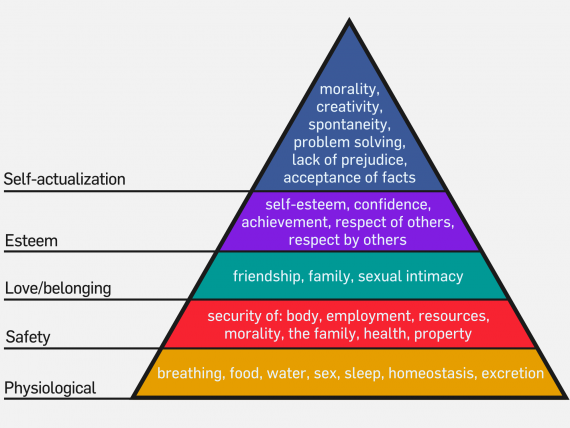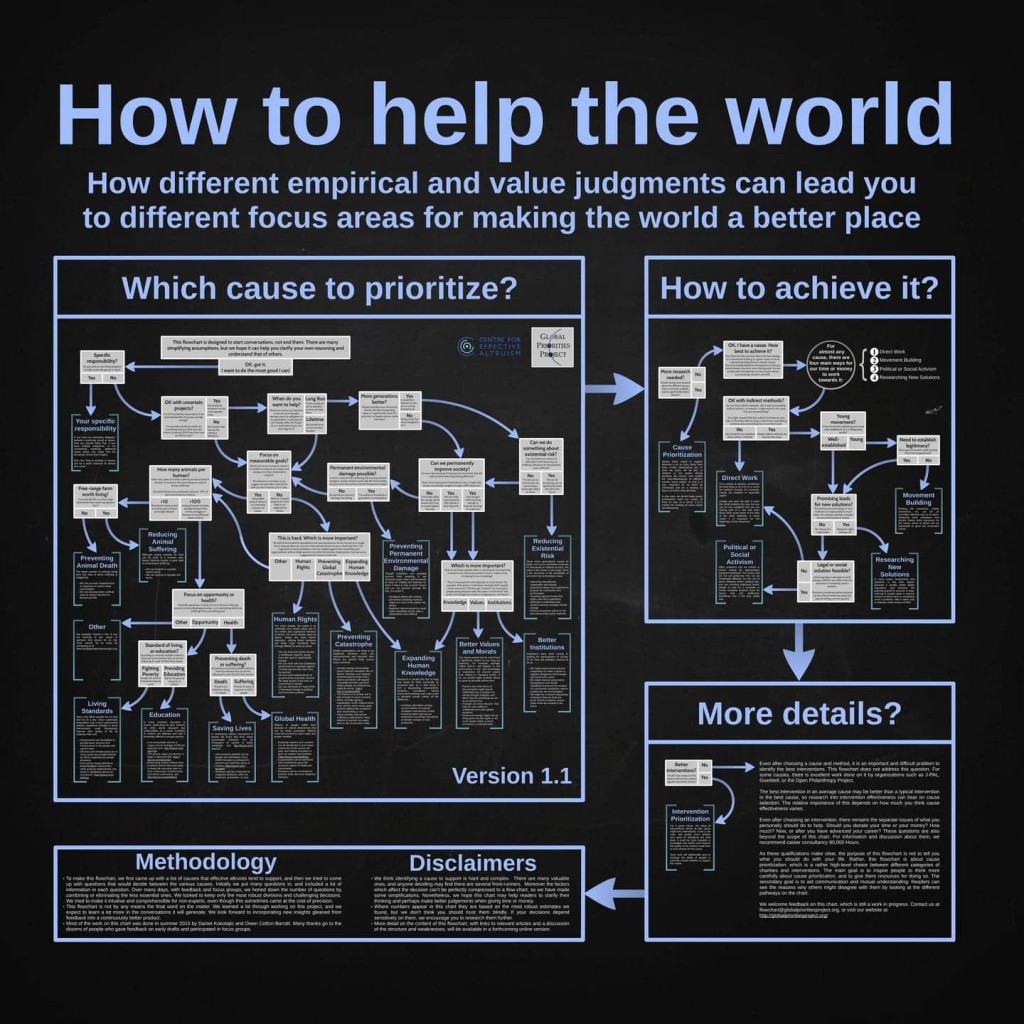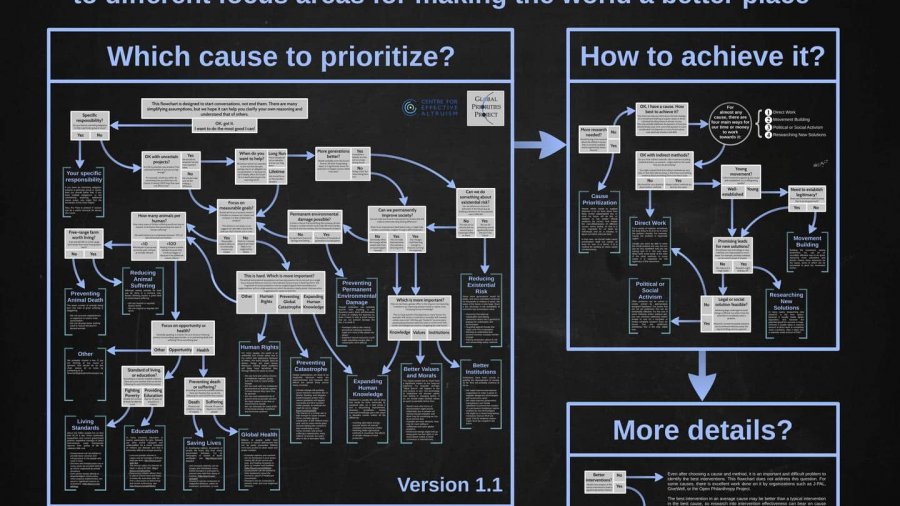Abraham Maslow, one of the most influential psychologists of the 20th century, is perhaps best-known for developing Maslow’s hierarchy of needs—a theory of human development.
The theory postulates that human motivations generally progress in a particular pattern which correlates with the fulfillment of certain needs.
Maslow’s hierarchy of needs is typically represented as a pyramid, with the most basic human needs at the bottom and the most sophisticated needs at the top:

Maslow’s hierarchy of needs. Credit: Wiki Commons
Although Maslow’s hierarchy has received some criticism, it’s a decidedly useful model of human development.
This essay will focus on a problem individuals encounter once their basic needs are met and they begin to feel a need to self-actualize, or to put “a dent in the universe”: the problem of how to live an ethical life.
One aspect of the need for self-actualization is a need to be good, to live a moral and ethical life. Though many are aware of Maslow’s hierarchy, fewer realize that in his later life, Maslow revised his theory to include a dimension beyond self-actualization: self-transcendence. Maslow insisted that the self finds its ultimate actualization only when it transcends itself—by working altruistically to further some higher cause and communing with that which lies beyond its boundaries through aesthetic and/or mystical experience.
Maslow’s research suggests that individual fulfillment may be dependent upon finding some world-improving cause to which to contribute. For many of us, this need for altruism manifests as a persistent question: “How can I help the world?”
If you’ve ever taken this question seriously, you might have some sense of the fathomless Pandora’s Box of possibilities one discovers beneath it.
Gazing into Pandora’s Box
You see, this question—”How can I help the world?”—is far more complicated nowadays than at any point prior. For most of human history, the answer was pretty straightforward: be kind to your neighbors and learn useful skills to benefit your tribe/community. And in a broad sense, that is still the answer.
But, hold on a second. Let’s remember that we no longer live in nomadic tribes of a couple hundred people. In the 21st century, we understand ourselves as members of exponentially larger communities, the largest of which is a global community of 7 billion human beings and billions more sentient beings.
We find ourselves at a seemingly pivotal historical moment—a moment in which technology is changing rapidly, bringing with it a host of wondrous boons and fascinating new possibilities, as well as a host of serious problems, some of which may even pose an existential risk to the human species and all intelligent earthly life.
We live in a time in which nuclear war is a real possibility; a time in which the largest refugee crisis since WWII is taking place; a time in which the most massive earthly extinction event in 66 million years is occurring and various environmental catastrophes/crises loom; a time in which theorists speculate that unfriendly superintelligent AI could soon threaten humanity’s existence; a time in which scientists postulate that advances in biotech and nanotech might likewise threaten our existence; a time in which immense power is concentrated in the hands of a small fraction of people who control the majority of global wealth; a time in which we know that hundreds of millions of our fellow humans are living without adequate food, water, healthcare, education, and/or shelter; a time in which approximately 20 million humans are dying every year from poverty.
We are able to understand that our actions as a species at this juncture will determine whether countless future generations of humans and other sentient beings will have the opportunity to exist. We can see that our collective choices will determine whether Earth’s biosphere and biodiversity will thrive into the deep future, or whether they will be decimated or even irreparably damaged in the coming centuries.
In light of these factors, it becomes clear that the question of “How can I help the world?” is now infinitely more complex than it was for most of human history. There are far more issues to address, far more possible courses of action, far more humans/sentient beings to consider, and the stakes are momentously high. Our world is a precarious, hyper-complex web of relations, systems, and processes, careening on a trajectory toward ever-greater technological sophistication. No single person can fully comprehend what is going on, and thus no one can say for certain which individual and collective actions will ultimately (most) benefit the world.
The Messiness of Ethics
Nonetheless, in the midst of this, many age-old means of helping the world yet seem like valid options—you know, being kind, being useful in your community, that sort of thing. Those options are unlikely ever to go out of style. Then there are other things—like recycling and transitioning to renewable forms of energy—that most of us now acknowledge as important ways of helping the world, though for most of human history these ideas would have been irrelevant or not understood. And then there are other things—like, say, moving all biotech and nanotech development out of Earth’s orbit and starting a second human civilization on Mars—that would yet seem like the substance of a bizarre science-fiction movie to most humans, but which may end up being indispensable to the long-term continuation of our earthly evolutionary branch.
These wildly different approaches to improving the world are indicative of the complexity of our current global situation. They’re also indicative of the messiness of ethics. We humans have many different ethical perspectives—perhaps 7 billion different ethical perspectives. Depending on their background, values, and education, two humans might have totally different notions of how to help the world, or of whether “helping the world” is even a sensible endeavor. This raises an important question:
Do we have any objective means of determining whose ethics are “correct” or whose are best?
The answer is no, we probably don’t. Every single definition of what it means to help the world or be a good person will inevitably rely on certain subjective value judgments about the nature of “good” and “bad.”
I should note that there are one or two fascinating models of ethical development that assert that we can show empirically that some ethical perspectives are more accurate and sophisticated than others. I find these models quite fascinating and useful, though I’m not convinced that they actually provide an objective basis for deeming one ethical perspective “better” or more correct than another.
You might ask: “Where does that leave us? How can we possibly help the world if we have no objective basis for knowing what it means to ‘help the world’?”
Well, even if it’s true that there is no objective basis for our ethical suppositions, most all of us can agree that ethics are an indispensable human thing. We intuitively form ethical/moral guidelines; such guidelines seem essential to human community and human flourishing; and ethical/moral perspectives often serve to give us a sense of meaning and purpose in a strange universe. Most of us can agree that it is in our best interest as a species to have ethical/moral perspectives.
A Distinction That Might Help Us Emerge From This Tangle
The philosopher David Wiggins makes a distinction between “non-anthropocentric” and “anthropocentric” facts. Facts of chemistry, physics, and other hard sciences are non-anthropocentric—true regardless of what kind of creatures we are. Anthropocentric facts, by contrast, are only true given that we’re humans. The moral psychologist Jonathan Haidt (whose book The Righteous Mind I thoroughly recommend) emphasizes this distinction in his work and suggests that there are moral/ethical facts, but that that they are anthropocentric facts.
This distinction clarifies my thinking, in that it validates my assertion that objective moral/ethical facts do not exist, while also affirming my intuition that this doesn’t render morality/ethics useless, trivial, or hopeless. Within the context of humanity, certain moral/ethical statements can be so true as to be raised to the status of “anthropocentric facts”—e.g. violently murdering someone because of their beliefs is worse than not doing that. Of anthropocentric moral/ethical facts, Haidt writes:
“Similarly, a culture that oppresses categories of people against their will is worse than one that does not. Massive human rights violations, in which large numbers of victims are crying out for foreign assistance, can justify a military response from other nations. But the fact that humanity has reached that point is an emergent fact about modernity and our changing moral standards. I do not think it was morally incumbent upon ancient Rome to stop human rights abuses in neighboring kingdoms. Moral facts are not eternal and universal in the way that non-anthropocentric facts are.”
Interestingly, Haidt suggests that moral/ethical facts that did not exist previously can emerge at a particular stage of humanity’s development, as a result of changing moral standards. He does not suggest that moral/ethical facts are universally true at all points in history, but rather are to some extent contingent upon humanity’s collective moral/ethical development. This way of thinking about the problem makes sense to me.
The question then becomes: How can we determine these anthropocentric moral/ethical facts?
One answer: We might employ an ethical concept or framework—like the concept of human rights or the framework of utilitarianism—and treat its conclusions as anthropocentric facts. This is basically the approach of the effective altruism movement, which I’ll discuss in greater depth below.
Another approach to discerning moral/ethical facts might be to ask a straightforward question: What do we all agree on?
If we look at the general human consensus on what does and does not constitute moral/ethical behavior, we might find that a number of moral/ethical facts quickly become apparent.
What Do We All Agree On?
Our various human ethical/moral perspectives tend to have a lot in common with one another. Even though we will almost certainly never agree on a single Best Ethics (and probably we wouldn’t want to), it’s likely that we can find sufficient common ground to allow us to take many important actions. Based on my particular form of ethics (which is something like an ecocentric/biocentric ethical responsiveness that utilizes utilitarianism, virtue ethics, and other ethical approaches as lenses rather than strict systems), here are a few principles I would put forth as worthy guideposts for how humanity might improve/save the world at this stage of history:
1. Avoid the extinction of humanity and the extinction of all earthly life
2. Avoid permanently damaging the Earth’s ecosystems and destroying its biodiversity
3. Avoid inflicting brutal forms of suffering upon other humans and sentient beings
4. Cooperate with one another and with the Earth rather than dominate and exploit
5. Meet the basic survival needs of all humans so that no one has to die from poverty
6. Aim to cultivate basic compassion for all sentient beings
I certainly have other principles and ideas regarding ways in which our current world could be improved, but these are a few of the ideals that I personally believe to be of paramount importance if we want humanity and many other earthly lifeforms to survive and thrive into the deep future.
I think it would be a worthwhile exercise for you to take some time now to brainstorm and see what your list of Principles for Helping the World might look like. I’m guessing you’ll find that our lists have a certain amount of overlap. If this is the case, it’s a good sign, as it indicates that although we humans will never entirely agree about the best ways to improve our world, we can discover common ground and work from there.
At the very least, I think the vast majority of humans would agree that human extinction is an undesirable outcome. Unless you’re a member of the Voluntary Human Extinction Movement or some other fringe group, it probably seems like common sense that we don’t want our species to die out. And that’s fantastic! If 99% of us can agree on this one thing, it follows that we can agree that our collective ethics should include a commitment to address the various existential risks that might threaten humanity, as well as a commitment to transform earthly human civilization into a sustainable, regenerative enterprise.
It seems that if a whole bunch of us can agree on even a few fundamental ethical principles—or, anthropocentric ethical facts—we can quickly make significant progress in mapping out what needs to be done to improve/save the world. One might then ask:
Is there some entity that can help a whole bunch of people to agree on a few sound fundamental ethical principles?
One Solution: Effective Altruism
Throughout history, there have been many attempts to determine a set of fundamental ethical principles that can guide humanity in the direction of long-term flourishing.
The effective altruism (hereafter referred to as “EA”) movement is one of the most promising recent attempts to do this. The EA movement, which originated about a decade ago, is a rapidly growing constellation of people and organizations dedicated to using empirical evidence to determine the most effective ways of helping the world. Effective altruism employs a utilitarian ethical framework, meaning (in simplified terms) that it seeks to create “the greatest good for the greatest number of people/animals.”
In EA, I see extraordinary potential to improve the world; I see a vision that I believe can benefit all earthly life and all future generations of humans/sentient beings—a vision I think a majority of humans would at least partially support. One of the most central values of EA is the long-term preservation of human/sentient life. Thus, avoiding (human) extinction is viewed as a top priority. As I said, I think 99% of humans would be on board with this. A few other principles that many effective altruists tend to support:
1. Reduce unnecessary/excessive human and animal suffering as much as possible, in the most efficient way possible; maximize collective well-being.
2. Don’t consider one life to be inherently more valuable than another; a life in a far-distant country should be valued as much as a life in our hometown.
3. Animal life is profoundly valuable, so animal welfare/suffering must be prioritized; animal lives/rights should perhaps be considered as valuable as those of humans.
You might agree with all of these principles. You might not agree with any of them. The beauty of EA is that you don’t have to agree entirely with many of the movement’s fundamental ideas to benefit from its work. Even if you simply agree that human extinction should be avoided, or that unnecessary human/animal suffering should be reduced, I’m certain you’ll find much of interest/value in the work of effective altruists.
Perhaps the most exciting thing about EA is that it is uniting tens of thousands of smart folks under a general philosophy of helping the world. I think almost any human would connect with and support some of the major aims of EA, making it an immensely powerful force for directing humanity’s efforts to help the world.
A Flowchart for Determining How to Help the World
Some of the most fascinating and necessary work being done in the EA movement is in the domain of cause prioritization—i.e. determining which global issues are most pressing and determining on what basis we should prioritize one cause over another.
If we can gain an awareness of the most pressing global issues, as well as an understanding of why some people think particular issues are more pressing than others, we can move closer to a unified approach to improving the world, or at least a greater sense of solidarity in our diverse efforts to make things better.
There is one particular tool that has come out of the EA movement that I think is extraordinarily valuable in this regard. It’s an elaborate flowchart that facilitates reflection on the most pressing global issues and helps one to understand how differing values lead different people to prioritize certain issues over others.
This flowchart is one of the best tools I’ve found for cutting through the complexity to determine how best to help the world, based on your particular ethics/morality. Reading through it has helped me to clarify my understanding of what it means to help the world, how I can best help the world, and how other people’s differing beliefs and value judgments lead them to alternate paths of helping the world.
You’ll have to click here to see a massive image of the chart that will allow you to read the whole thing. You can also view the chart as a Prezi presentation.

On the Origins of the Flowchart
The Global Priorities Project is the specific EA organization that created this flowchart. It was created in response to the realization that one of the greatest challenges in determining how to effectively help the world is in determining how to prioritize certain causes and problems over others, based on the expected impact of working in various areas.
(Another EA organization—80,000 Hours, an organization which helps individual choose careers that will have the greatest global impact—has also undertaken this sort of work, and has even gone as far as to release a ranked list of the world’s most urgent problems, based on the potential worst-case scenarios of each problem, the neglectedness of the problem, and other factors. One issue with a list like that of 80,000 Hours’, though, is that its ranking system is based on certain assumptions and value judgments that are not shared universally. For this reason, 80,000 Hours does not simply recommend that everyone try to work on the absolute top problems. They’ve developed tools and quizzes to help people determine—based on their unique skills, interests, and value judgments—which focus area is most suitable for them. 80,000 Hours is a fantastic organization, and the Global Priorities Project recommends that individuals utilize their tools for determining potential career directions.)
Here’s a description from the Global Priorities Project website of how this flowchart came into existence:
“We’re interested in helping people to choose between different focus areas for helping the world. A complication is that people can have very different background assumptions, which makes it hard to give uniform recommendations. On the other hand, discussing the assumptions directly may not help if it’s unclear how they are decision-relevant.
To address this, we’ve been working on a flowchart which maps out how different ethical and empirical assumptions can lead us to support different areas. We hope this can serve as a tool to help people clarify their own thinking, understand where others may be coming from, or identify which questions most need further thought.”
Although the Global Priorities Project doesn’t recommend that individuals make career decisions based on this flowchart (again, they recommend 80,000 Hours), it’s nonetheless an invaluable tool for understanding:
1. Some of the most pressing problems facing humanity/sentient life in our age
2. Which causes you are likely to care most about, given your unique worldview
3. How different perspectives on certain fundamental ethical questions result in different people prioritizing a diverse range of approaches to helping the world
Do note that this flowchart is not meant to provide definitive, final answers. As it says on the chart:
“This flowchart is designed to start conversations, not end them. There are many simplifying assumptions, but we hope it can help you clarify your own reasoning and understand that of others.”
My Hope
My hope is that spreading this flowchart will raise awareness of some of the lesser-known, pressing issues of our present age and clarify/broaden your thinking about ways to help the world. I also hope that spreading the flowchart will increase understanding between people who have different philosophies of improving the world. Finally, I hope that this flowchart can help to promote a sense of solidarity among those who wish to help the world; although we may have different approaches, if we can agree on a few fundamental aims, we can be more focused in our efforts and realize that we’re on the same team: the team of those who wish to reduce unnecessary suffering and facilitate the long-term flourishing of earthly life.
I would be much obliged if you would take the time to read through and ponder the entire chart. Please utilize this amazing tool, and pass it on to other curious minds. Here’s to co-creating a more cooperative, harmonious, sustainable human enterprise.
———
A version of this essay was first published on HighExistence.
Further Study:
The Most Good You Can Do by Peter Singer
If you’re interested in the EA movement and want to learn more about it, I highly recommend this book. It’s a brilliant overview of the movement that will challenge your thinking, inform you, and inspire you.
Also, Sam Harris interviewed Will MacAskill, one of the founders of EA, on his podcast. It’s one of the best podcast episodes I’ve ever listened to and a phenomenal introduction to EA.
About Jordan Bates
Jordan Bates is a Lover of God, healer, mentor of leaders, writer, and music maker. The best way to keep up with his work is to join nearly 7,000 people who read his Substack newsletter.






Oh man this is such a rad article. Cudos